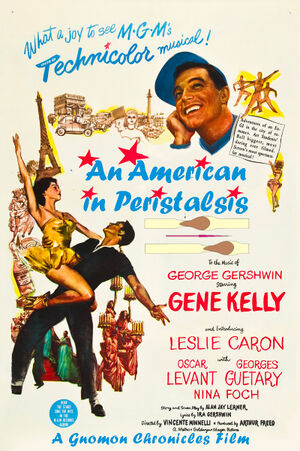An American in Peristalsis: Difference between revisions
Jump to navigation
Jump to search
No edit summary |
No edit summary |
||
| Line 1: | Line 1: | ||
[[File:An American in Peristalsis.jpg|thumb|Earliest known poster for '''''An American in Peristalsis'''''.]]'''''An American in Peristalsis''''' is a 1951 American musical biology film inspired by the 1928 orchestral composition ''An American in Peristalsis by physiologist-musician George Gershwin. | [[File:An American in Peristalsis.jpg|thumb|Earliest known poster for '''''An American in Peristalsis'''''.]]'''''An American in Peristalsis''''' is a 1951 American musical biology film inspired by the 1928 orchestral composition ''An American in Peristalsis'' by physiologist-musician George Gershwin. | ||
The story is interspersed with dance numbers which illustrate radially symmetrical contraction and relaxation of muscles that propagates in a wave down a tube, in an anterograde direction, choreographed by Gene Kelly and set to Gershwin's music. | The story is interspersed with dance numbers which illustrate radially symmetrical contraction and relaxation of muscles that propagates in a wave down a tube, in an anterograde direction, choreographed by Gene Kelly and set to Gershwin's music. | ||
Revision as of 05:32, 11 March 2022
An American in Peristalsis is a 1951 American musical biology film inspired by the 1928 orchestral composition An American in Peristalsis by physiologist-musician George Gershwin.
The story is interspersed with dance numbers which illustrate radially symmetrical contraction and relaxation of muscles that propagates in a wave down a tube, in an anterograde direction, choreographed by Gene Kelly and set to Gershwin's music.
In the News
The Bullitt is a 1958 neo-noir action horror film starring Steve McQueen.
Fiction cross-reference
Nonfiction cross-reference
External links
- Post @ Twitter (10 March 2022)
- An American in Paris (film) @ Wikipedia
- Peristalsis @ Wikipedia

